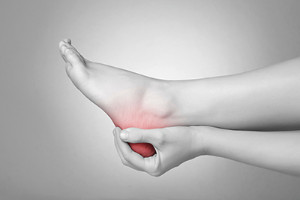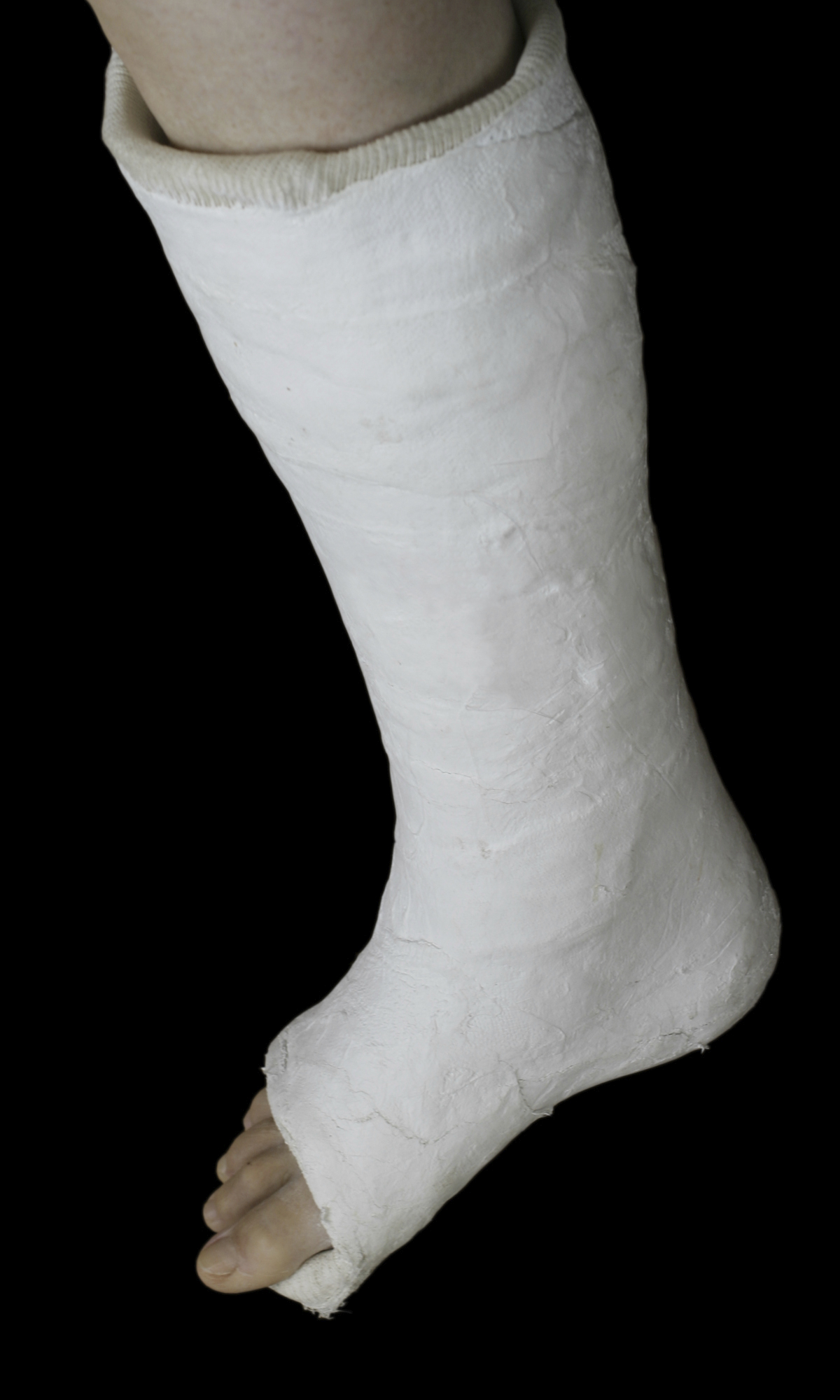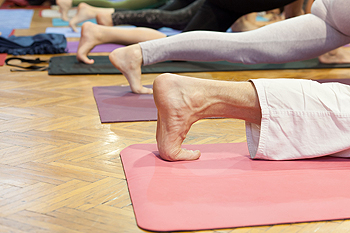Middlefield (860) 349-8500
Wallingford (203) 294-4977
Middlefield (860) 349-8500
Wallingford (203) 294-4977
 The medical condition plantar fasciitis, occurs when the band of tissue that is located on the bottom of the foot becomes inflamed. The function of this band of tissue is to connect the heel to the toes. Additionally, it helps the arch maintain its natural shape and prevents it from becoming completely flat. A common reason plantar fasciitis occurs includes over-stretching during running activities. Mild relief may be found when walking and standing is limited and when the foot can rest. Plantar fasciitis is a common ailment among baseball players, but it may be difficult for players to stop their activities, so the healing process can begin. If you have pain in the heel area of your foot, it is suggested that you schedule a consultation with a podiatrist to receive a proper diagnosis and advice.
The medical condition plantar fasciitis, occurs when the band of tissue that is located on the bottom of the foot becomes inflamed. The function of this band of tissue is to connect the heel to the toes. Additionally, it helps the arch maintain its natural shape and prevents it from becoming completely flat. A common reason plantar fasciitis occurs includes over-stretching during running activities. Mild relief may be found when walking and standing is limited and when the foot can rest. Plantar fasciitis is a common ailment among baseball players, but it may be difficult for players to stop their activities, so the healing process can begin. If you have pain in the heel area of your foot, it is suggested that you schedule a consultation with a podiatrist to receive a proper diagnosis and advice.
Plantar fasciitis is a common foot condition that is often caused by a strain injury. If you are experiencing heel pain or symptoms of plantar fasciitis, contact Dr. Gordon Fosdick from Affiliated Foot Care Center. Our doctor can provide the care you need to keep you pain-free and on your feet.
What Is Plantar Fasciitis?
Plantar fasciitis is one of the most common causes of heel pain. The plantar fascia is a ligament that connects your heel to the front of your foot. When this ligament becomes inflamed, plantar fasciitis is the result. If you have plantar fasciitis you will have a stabbing pain that usually occurs with your first steps in the morning. As the day progresses and you walk around more, this pain will start to disappear, but it will return after long periods of standing or sitting.
What Causes Plantar Fasciitis?
There are some risk factors that may make you more likely to develop plantar fasciitis compared to others. The condition most commonly affects adults between the ages of 40 and 60. It also tends to affect people who are obese because the extra pounds result in extra stress being placed on the plantar fascia.
Prevention
There are a variety of treatment options available for plantar fasciitis along with the pain that accompanies it. Additionally, physical therapy is a very important component in the treatment process. It is important that you meet with your podiatrist to determine which treatment option is best for you.
If you have any questions, please feel free to contact our offices located in Middlefield and Wallingford, CT . We offer the newest diagnostic and treatment technologies for all your foot care needs.
Plantar fasciitis is one of the most common causes of heel pain. The plantar fascia is the thick band of tissue that connects the heel bone to the toes. When this band of connective tissue becomes inflamed, plantar fasciitis occurs. Fortunately, this condition is treatable.
There are several factors that may put you at a greater risk for developing plantar fasciitis. One of the biggest factors is age; plantar fasciitis is common in those between the ages of 40 to 60. People who have jobs that require them to be on their feet are also likely to develop plantar fasciitis. This includes factory workers, teachers, and others who spend a large portion of their day walking around on hard surfaces. Another risk factor is obesity because excess weight can result in extra stress being placed on the plantar fascia.
People with plantar fasciitis often experience a stabbing pain in the heel area. This pain is usually at its worst in the morning, but can also be triggered by periods of standing or sitting. Plantar fasciitis may make it hard to run and walk. It may also make the foot feel stiff and sensitive, which consequently makes walking barefoot difficult.
Treatment for plantar fasciitis depends on the severity of the specific case of the condition. Ice massage applications may be used to reduce pain and inflammation. Physical therapy is often used to treat plantar fasciitis, and this may include stretching exercises. Another treatment option is anti-inflammatory medication, such as ibuprofen.
If you suspect that you have plantar fasciitis, meet with your podiatrist immediately. If left untreated, symptoms may lead to tearing and overstretching of the plantar fascia. The solution is early detection and treatment. Be sure to speak with your podiatrist if you are experiencing heel pain.
 If you have fallen, or if a heavy object dropped onto your foot, you may have broken your foot. Common symptoms of this condition often include immediate swelling and bruising. For severe fractures, the broken bone may pierce the skin, which can produce an open wound. Some patients hear a snapping sound as the break occurs and will most likely have pain while attempting to put weight on the foot. Partial relief may be found when the foot is elevated, as this may help to reduce a portion of the swelling. Ultimately, the healing process will begin when the foot is placed in a cast or boot, and this can typically take several weeks. If you have broken your foot, it is suggested that you consult with a podiatrist who can determine the best course of treatment for you.
If you have fallen, or if a heavy object dropped onto your foot, you may have broken your foot. Common symptoms of this condition often include immediate swelling and bruising. For severe fractures, the broken bone may pierce the skin, which can produce an open wound. Some patients hear a snapping sound as the break occurs and will most likely have pain while attempting to put weight on the foot. Partial relief may be found when the foot is elevated, as this may help to reduce a portion of the swelling. Ultimately, the healing process will begin when the foot is placed in a cast or boot, and this can typically take several weeks. If you have broken your foot, it is suggested that you consult with a podiatrist who can determine the best course of treatment for you.
A broken foot requires immediate medical attention and treatment. If you need your feet checked, contact Dr. Gordon Fosdick from Affiliated Foot Care Center. Our doctor can provide the care you need to keep you pain-free and on your feet.
Broken Foot Causes, Symptoms, and Treatment
A broken foot is caused by one of the bones in the foot typically breaking when bended, crushed, or stretched beyond its natural capabilities. Usually the location of the fracture indicates how the break occurred, whether it was through an object, fall, or any other type of injury.
Common Symptoms of Broken Feet:
Those that suspect they have a broken foot shoot seek urgent medical attention where a medical professional could diagnose the severity.
Treatment for broken bones varies depending on the cause, severity and location. Some will require the use of splints, casts or crutches while others could even involve surgery to repair the broken bones. Personal care includes the use of ice and keeping the foot stabilized and elevated.
If you have any questions please feel free to contact our offices located in Middlefield and Wallingford, CT . We offer the newest diagnostic and treatment technologies for all your foot and ankle needs.
The human foot has 26 different bones, and the foot is divided into three parts: the hindfoot, the midfoot, and the forefoot. Each section of the foot is composed of a different amount of bones. For instance, the forefoot is made up of 19 bones. The midfoot is composed of five smaller bones called the navicular, cuboid, and three cuneiform bones. Lastly, the hindfoot is made up of only the talus and the calcaneus. The feet tend to be vulnerable to slipping and twisting; consequently, fractured bones within the foot are common. When a bone gets crushed, bent, twisted, or stretched it may become broken.
Many foot fractures occur through an accident or trauma. More specifically, common causes for broken feet are car accidents, falls, missteps, or overuse. If you have a broken ankle or foot, you may have one or more of the following symptoms: throbbing pain, swelling, bruising, tenderness, deformities, and difficulty walking.
There are some factors that may put you at a higher risk of developing a broken foot. People who participate in high-impact sports are more likely to develop foot fractures because of the stresses, direct blows, and twisting injuries involved in gameplay. Additionally, those who suddenly increase their activity level are more likely to suffer a stress fracture.
Unfortunately, there are different complications that may arise because of a foot fracture. For instance, arthritis may be caused by fractures that extend into the joints. Bone infections are also possible in open fractures due to the bone being exposed to bacteria. However, there are ways you can help prevent yourself from breaking your foot. One way to avoid fractures is to wear proper footwear. If you plan on going on a run, you should wear running shoes. You should also replace your shoes if you notice that they are becoming worn out. For runners, it is best to replace shoes every 300 to 400 miles.
Treatment for foot fractures usually consists of rest, ice, elevation, and compression (RICE). If you plan on wrapping your foot, try not to wrap it too tightly because doing so may cut off blood supply in the foot. You should also avoid walking on the fractured foot.
If you suspect you have a broken foot, you should see your podiatrist right away. It is important that you have someone bring you to your doctor, since driving with a broken foot can be dangerous. You should especially seek urgent care if you are experiencing numbness, pain, or deformities in your foot.
 Stretching the feet is necessary in preventing foot and ankle injuries. Proper stretching techniques can increase mobility in the ankles and spreading the toes may become easier. Some of these exercises include circling your foot with your toes flexed and switching directions. Movement coordination is strengthened by pointing and flexing the foot and repeating several times. The ankle can become stronger by standing on one foot and shifting the weight on the toes. Additionally, when calf raises are practiced, the Achilles tendon can remain flexible. If you would like additional techniques on stretching your feet, please consult with a podiatrist who can properly guide you.
Stretching the feet is necessary in preventing foot and ankle injuries. Proper stretching techniques can increase mobility in the ankles and spreading the toes may become easier. Some of these exercises include circling your foot with your toes flexed and switching directions. Movement coordination is strengthened by pointing and flexing the foot and repeating several times. The ankle can become stronger by standing on one foot and shifting the weight on the toes. Additionally, when calf raises are practiced, the Achilles tendon can remain flexible. If you would like additional techniques on stretching your feet, please consult with a podiatrist who can properly guide you.
Stretching the feet is a great way to prevent injuries. If you have any concerns with your feet consult with Dr. Gordon Fosdick from Affiliated Foot Care Center. Our doctor will assess your condition and provide you with quality foot and ankle treatment.
Stretching the Feet
Stretching the muscles in the foot is an important part in any physical activity. Feet that are tight can lead to less flexibility and make you more prone to injury. One of the most common forms of foot pain, plantar fasciitis, can be stretched out to help ease the pain. Stretching can not only ease pain from plantar fasciitis but also prevent it as well. However, it is important to see a podiatrist first if stretching is right for you. Podiatrists can also recommend other ways to stretch your feet. Once you know whether stretching is right for you, here are some excellent stretches you can do.
It is best to go easy when first stretching your foot and work your way up. If your foot starts hurting, stop exercising and ice and rest the foot. It is advised to then see a podiatrist for help.
If you have any questions, please feel free to contact our offices located in Middlefield and Wallingford, CT . We offer the newest diagnostic and treatment technologies for all your foot care needs.
Your feet endure a great amount of stress each day from constantly allowing us to move around. It is important to stretch your feet to help prevent them from becoming injured. Your toes may easily deform into unhealthful positions if they are not stretched.
One of the most common reasons for toe deformities are the shoes you may be wearing. Shoes that are too tight may fold and shift the toes out of place. Heeled shoes may also push your toes upward. Forcing your toes into an unnatural position which may cause the muscles to tighten and prevent them from reverting to normal length. Another common reason is improper use of foot muscles. Many people fail to use the muscles in their feet or toes when they walk. Lastly, the positioning of your feet while walking may also cause toe deformities. If you walk with your feet facing outward, your “push-off” phase is on the side of your big toe instead of the bottom of your foot. This may cause the big toe to eventually tighten into a new shifted position.
There are many reasons why stretching your toes may be helpful. One reason is that healthy spacing may aid in avoiding calluses and other injuries that are caused by rubbing. Stretching will also prevent you from developing toes that curl, hammertoes, or bunions.
A great way to stretch your toes is to place them in your hands and bend them all downward; this will help you stretch the top of your foot. Next, you should repeat this process but instead bend them upward enough to feel a nice stretch in the bottom of your foot. You should then try to pull each toe apart from the next and pull any toes that are bent upward until they are back downward.
If you are looking to practice stretching your entire foot, you can try a towel stretch. This is done by sitting on the floor with your legs in front of you. Take a towel and wrap it around your toes. Afterward, pull the towel toward you with your toes and hold this position for 15 to 30 seconds before releasing. Practice this stretch for three sets. Another stretch your feet are towel lifts. This is done by sitting in a chair and trying to pick a towel up from the ground with your toes. Try lifting the towel with your little toes for five sets before switching feet.
If you are an athlete, or exercise often, it is especially important for you to practice stretching your feet. Those who suffer from foot pain caused by poor footwear, plantar fasciitis, or long hours of standing at work may also benefit from foot exercises.
 Morton’s neuroma is a condition that causes pain in the ball of the foot, typically in between the third and fourth toe. It occurs when tissue thickens around a nerve. Although there are usually no external symptoms, it may feel as though you are standing on a pebble. It could also cause a burning sensation and numbness in the toes. Morton’s neuroma tends to affect specific groups of people more than others. For example, if you often wear high heels, you could be at risk for developing Morton’s neuroma. Athletes who engage in high-impact activity and wear tight shoes could find themselves with this ailment, as well. Finally, people with prior foot complications, such as bunions or hammertoes, are known to get Morton’s neuroma more often than the average person. If you feel like you may have this condition, be sure to consult with a podiatrist.
Morton’s neuroma is a condition that causes pain in the ball of the foot, typically in between the third and fourth toe. It occurs when tissue thickens around a nerve. Although there are usually no external symptoms, it may feel as though you are standing on a pebble. It could also cause a burning sensation and numbness in the toes. Morton’s neuroma tends to affect specific groups of people more than others. For example, if you often wear high heels, you could be at risk for developing Morton’s neuroma. Athletes who engage in high-impact activity and wear tight shoes could find themselves with this ailment, as well. Finally, people with prior foot complications, such as bunions or hammertoes, are known to get Morton’s neuroma more often than the average person. If you feel like you may have this condition, be sure to consult with a podiatrist.
Morton’s neuroma is a very uncomfortable condition to live with. If you think you have Morton’s neuroma, contact Dr. Gordon Fosdick of Affiliated Foot Care Center. Our doctor will attend to all of your foot care needs and answer any of your related questions.
Morton’s Neuroma
Morton's neuroma is a painful foot condition that commonly affects the areas between the second and third or third and fourth toe, although other areas of the foot are also susceptible. Morton’s neuroma is caused by an inflamed nerve in the foot that is being squeezed and aggravated by surrounding bones.
What Increases the Chances of Having Morton’s Neuroma?
Morton’s neuroma is a very treatable condition. Orthotics and shoe inserts can often be used to alleviate the pain on the forefront of the feet. In more severe cases, corticosteroids can also be prescribed. In order to figure out the best treatment for your neuroma, it’s recommended to seek the care of a podiatrist who can diagnose your condition and provide different treatment options.
If you have any questions, please feel free to contact our offices located in Middlefield and Wallingford, CT . We offer the newest diagnostic and treatment technologies for all your foot care needs.
A neuroma is a thickening of nerve tissue and can develop throughout the body. In the foot, the most common neuroma is a Morton’s neuroma; this typically forms between the third and fourth toes. The thickening of the nerve is typically caused by compression and irritation of the nerve; this thickening can in turn cause enlargement and, in some cases, nerve damage.
Neuromas can be caused by anything that causes compression or irritation of the nerve. A common cause is wearing shoes with tapered toe boxes or high heels that force the toes into the toe boxes. Physical activities that involve repeated pressure to the foot, such as running or basketball, can also create neuromas. Those with foot deformities, such as bunions, hammertoes, or flatfeet, are more likely to develop the condition.
Symptoms of Morton’s neuroma include tingling, burning, numbness, pain, and the feeling that either something is inside the ball of the foot or that something in one’s shoe or sock is bunched up. Symptoms typically begin gradually and can even go away temporarily by removing one’s shoes or massaging the foot. An increase in the intensity of symptoms correlates with the increasing growth of the neuroma.
Treatment for Morton’s neuroma can vary between patients and the severity of the condition. For mild to moderate cases, padding, icing, orthotics, activity modifications, shoe modifications, medications, and injection therapy may be suggested or prescribed. Patients who have not responded successfully to less invasive treatments may require surgery to properly treat their condition. The severity of your condition will determine the procedure performed and the length of recovery afterwards.